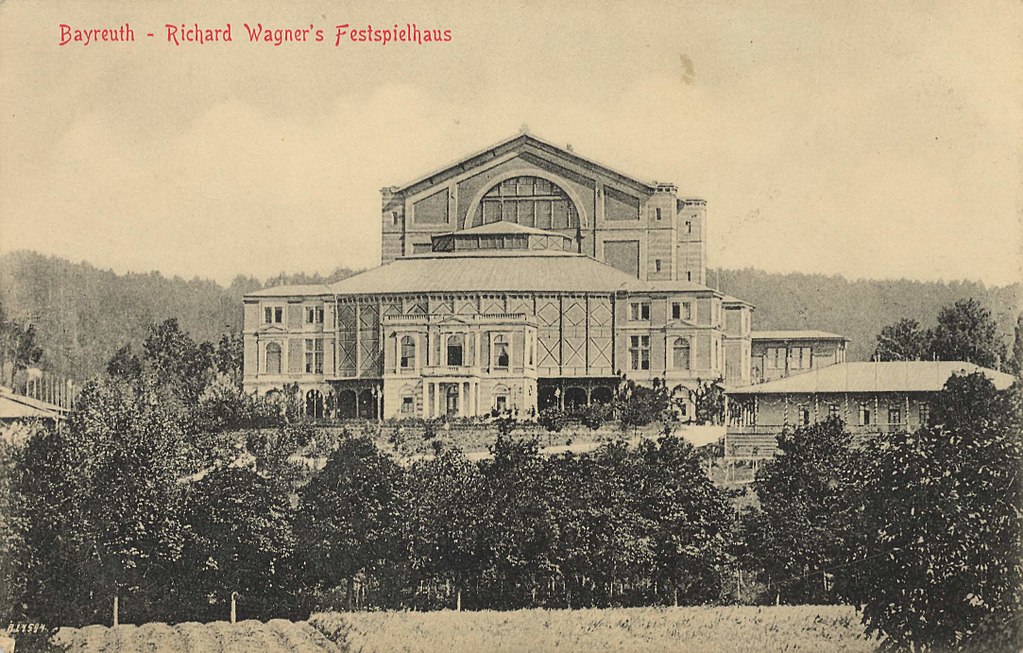Wagner’s Haus Wahnfried in Bayreuth: Tours, History, and Festivals
Wagner: Genius and Controversy
When talking about Richard Wagner, a musician often finds himself in troubling waters. The horrors of the Second World War marked his legacy in a way that might not be completely fair. But there is at least one thing we cannot deny: he was a genius. The ideas he developed, and the ways he went about developing them, were unheard of. Wagner stood on the barricades at the Weimar Revolution; he was chased and an outcast in multiple countries, deprived of any penny most of his life, living on the money of patrons, and falling in love with the wife of his patron—the inspiration for my favourite opera, Tristan und Isolde. From a technical point of view, this period also marked the beginning of atonal music: he used the ‘Tristan chord,’ a dissolving chord never used before, and he introduced the leitmotif, a musical motive linked to a personality to musically ‘announce’ a character on stage.
Yes, he wrote a pamphlet that was anti-Semitic, but so did many other composers, like Franz Liszt in his nearly 500-page book on Hungarian and Gypsy culture and music. Robert Schumann also made certain negative remarks about Jewish composers. Unfortunately, anti-Semitism was very common in the 19th century and must be seen in the historical context rather than judged solely through the lens of later events. When I perform music, especially Liszt’s arrangement of Tristan und Isolde, his political and other ideas don’t pop up in my mind as his music is so genius that there is no other possibility than being in awe. We should never forget that anti-Semitism was extremely present in the 19th century and that the bad aftertaste of the anti-Semitic period in the 20th century was after he died. His ideas on Germanism—mythology, music, ideas, and art forms—made him the perfect composer to enhance the cultural identity of his time and afterward, leaving an indelible mark on the artistic landscape of Germany.
Gesamtkunstwerk: Wagner’s Total Work of Art
One of the most incredible things Wagner created was not a ‘piece’ in particular but an idea: the ‘gesamtkunstwerk’ (‘Total Work of Art’), a concept that became a way of living for him. Every part of the opera was equally important; nothing was considered lesser. Everything was about the immersive experience. This idea continued in Villa Wahnfried, where he lived later in his life in Bayreuth. By going to the Villa, you will be immersed in this gesamtkunstwerk, and you will get the experience that will make you understand and deepen the experience while listening to his music.
Bayreuth and the Festspielhaus
Bayreuth was the city that allowed Richard Wagner, with the funding of King Ludwig II, to fully realize his vision. He created his own theatre, the Festspielhaus, with a revolutionary design. The orchestra pit was concealed beneath the stage to blend the orchestra and singers seamlessly, and Wagner designed a hood so that sound projected perfectly into the hall. He also supervised the auditorium seating to ensure that the audience was comfortable and fully integrated into the experience of the ‘gesamtkunstwerk.’ King Ludwig of Bavaria was fascinated by the composer and his ideas, and he funded the theatre entirely. The ideas and the vision Wagner had while creating this Festspielhaus were of such quality that they are now standard in nearly every opera house in the world that followed. It is of unbelievable importance from the point of view of opera culture and heritage and will make you understand that this was the birth of modern opera performance. It was so important in the 19th century that people from all over Europe would come and experience the opera performances in this hall, like Debussy and Chausson who would travel from Paris to Bayreuth.

Villa Wahnfried: Architecture and Inspiration
Villa Wahnfried is a must-see for anyone interested in Wagner’s music or the period he lived in. Every aspect of the house was designed or chosen to create a cohesive aesthetic and intellectual experience. The salon was especially important: it holds Wagner’s 2,300-volume library, silk wallpaper, a phenomenally beautiful piano, and ceiling ornamentation designed to help him compose and reflect.
Wagner’s inspiration came from mythology. In nineteenth-century Germany, mythology was closely linked to nationalism, and he used this as a cultural foundation for his work. This German mythology came from the Romantic writers Schlegel and Novalis, who wanted to create something authentic and something that the German people could relate to and be proud of. Writers like the Brothers Grimm and E.T.A Hoffmann would follow suit as they wrote works related to this. Wagner used these ideas himself in his operas, and it is key to understanding his compositions. Inside the villa, we can see paintings, statuettes, and costumes depicting the mythology of the Ring, the famous four-opera cycle.
The Wagner Museum: Artifacts and Memorabilia
The museum is a tribute to Wagner and his wife, Cosima. It showcases not only Wagner’s musical ideas, which are profoundly different from any other composer, but also the clothing (his flamboyant, hers classic), everyday objects, and furniture they used. As in all museums, there are letters, scores, paintings, and sculptures. Visitors can also read biographical notes highlighting key moments of Wagner’s life. The museum complex consists of three buildings: the main villa, the archives in the ‘Siegfried Wagner House,’ and an additional building for costumes and memorabilia. Both Wagner and Cosima (the daughter of Franz Liszt and Marie d’Agoult) are buried in the garden of Villa Wahnfried.
Louise Charles Elson describes how she found Cosima Wagner at the grave of her beloved husband:
I recalled a visit to that grave, when Madame Wagner had not yet taken up the noble mission which now causes her to live and to take interest in life. It was in 1883. The sudden death of her beloved husband had almost destroyed her reason. She had cut off her beautiful long tresses (because Wagner had admired them) and placed them in his coffin; Liszt had come to Bayreuth, but she refused to see him; only the boy, Siegfried, because he was the favourite of his father, was suffered to approach her; and every day, in rain or sunshine, she would sit two hours or more beside that lonely grave. She allowed none other near it, and it was only by the connivance of an underling that I was finally able to visit the resting place of the greatest composer of his epoch.
Visiting the Festspielhaus and Festivals
As mentioned, the Festspielhaus is a central part of the story of Wagner and Bayreuth. Pilgrimages by composers, enthusiasts, and music lovers from all over Europe were common, and the annual festival remains incredibly popular. Concerts still sell out years in advance, which will greatly affect your visit experience. If you are seeking a concert during the season, you are often in luck, as additional performances are frequently organized.
Other Museums in the Area:
There are two other interesting museums you could visit during your stay in Bayreuth. There is the Franz Liszt museum, which is small as the main one is in Weimar, and the Jean Paul Museum.
Liszt Museum
The connection between Wagner and Liszt was that Wagner was married to the daughter of Liszt, Cosima Wagner. Liszt himself loved living in Weimar but would travel relatively often to Bayreuth. In his will, he mentioned that he wanted to be buried ‘in the place where I die,’ meaning Weimar, but unfortunately, he died in Bayreuth in 1886 while visiting the Wagner Festival for its performances and was buried there. This museum is relatively small but there are quite some artifacts and one of his pianos. It is located close to the Wagner museum and definitely worth a visit when you are nearby. Franz Liszt is one of the most important composers for the piano. They say about Paganini that he completely transformed violin playing before and after him; I think it’s just as true to say that Liszt did the same for the piano.
A very curious anecdote from Felix Weingartner, a conductor in the epoch of Wagner and Liszt notes the following about the way the Wagner family treated the death of the great Franz Liszt:
The Wagner family gave no outward sign of mourning. The daughters wore black dresses and that was all. We had confidently expected that at least one of the festival performances would be cancelled...• If at least the flag on the roof of the theatre had been removed or hung at half-mast! But nothing, nothing at all was done to show outward reverence to his memory. Not even the receptions in the Villa Wahnfried were interrupted. Everything was made to look - as if on purpose - that Franz List's passing was not of sufficient importance to dim the glory of the Festivals even temporarily by a veil of mourning.
From that time on I never entered the portals of Wahnfried again.
(Quote from 'The Book of Musical Anecdotes, by Norman Lebrecht')
Jean Paul Museum
The other museum, in Weimar, is about the writer and poet Jean Paul. It is based in the former house he rented. The generous Dr. Hauser, who donated his private collection to the town, initiated the museum. It is connected to Wagner because his daughter lived in the building as well. The collection consists of many books, manuscripts, art, and stories about his life. It is beautifully designed by Dr. Frank Piontek and exhibition designer Florian Raff under the direction of Dr. Sven Friederich. Jean Paul was an extremely famous writer in his time and was very important for the ideas of composers. Especially Schumann loved his works.
The times around 1800 were extremely important for writers in Germany; there was literally a ‘reading-fury’ where fairytales and many other novels were created by writers like Jean Paul and E.T.A. Hoffmann. They were often drawn to the area of Weimar and Bayreuth, where, in the generation before them, Goethe and Schiller were working around Fichte, Schlegel, Herder, and the Humboldt brothers. This whole cycle was known as ‘Weimar Classicism’ and was crucial in the development of German Romantic culture.
Practical Info for Visitors
Villa Wahnfried / Richard Wagner Museum
Richard-Wagner-Straße 26, 95445 Bayreuth, Germany
Website: https://www.wagnerstiftung.de/en/museum/
September until June: Tuesday to Sunday, 10 am to 5 pm
July and August: Monday to Sunday, 10 am to 6 pm
Admission Fees — Richard Wagner Museum, Bayreuth
- Adults: €10
- Students: €8
- “Blue Hour” Admission (from 4 PM, September to June): €8
- Groups (per person, from 10 people): €8
- Annual membership (non-transferable): €40
Combi-card (valid for one week after purchase): €11 — includes one entrance each to:
- Richard Wagner Museum
- Franz Liszt Museum
- Jean Paul Museum

Whether aboard Viking, AmaWaterways, Avalon, or Uniworld, experience Europe’s musical soul through insider access and expert planning. With years on the concert stage and deep cultural knowledge, we at DeSalvio Travel offer personalized tours to the best composer homes, music festivals, and hidden gems. Turn your cruise into a musical trip with a custom itinerary.
Book a call now for consultation

Robert Poortinga
Travel Booking Assistant
River cruise & Europe destination expert
Culinary and art travel specialist
.svg)
_Black.png)